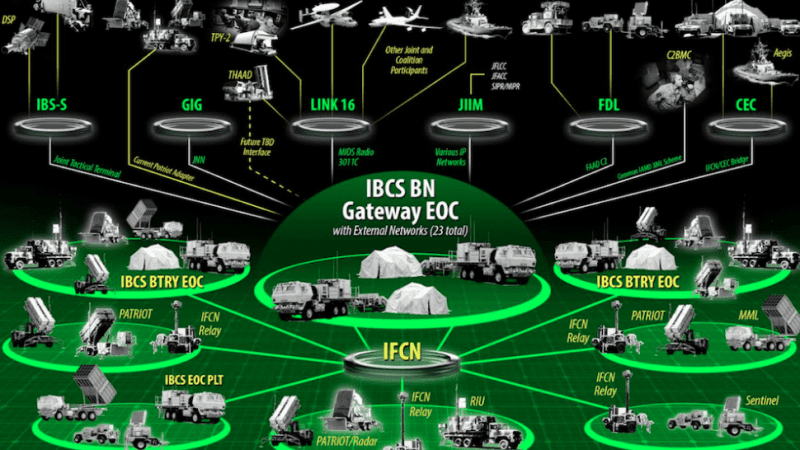IBCS - "Heart" of the Wisła Air Defence System. What is the Cost? [INTERVIEW]

For the Wisła system, I can confirm that the entire value of the IBCS is less than fifteen percent of the entire foreign military sales package, and that includes some IBCS-related offets as well. Even representing less than fifteen percent, IBCS is the heart of the Wisła project, it makes the system a truly integrated air defence system - as Mr Tarik Reyes, Vice President, Missile Defense and Protective Systems at Northrop Grumman, has told Defence24.pl in an interview.
Jakub Palowski: In November, the DSCA notified Congress on the approval of the potential sale of AIAMD-enabled, IBCS-integrated Patriot system to Poland. However, the maximum value of the sale was set at the level of $10.5 billion, which far exceeds the Polish expectations. According to the Polish Ministry of Defence, the contract may not be signed until the price is significantly lower. How would you comment on that?
Tarik Reyes, Vice President, Missile Defense and Protective Systems at Northrop Grumman: For the Wisła system, I can confirm that the entire value of the IBCS is less than fifteen percent of the entire foreign military sales package, and that includes some IBCS-related offsets as well. Even representing less than fifteen percent, IBCS is the heart of the Wisła project, it makes the system a truly integrated air defence system.
When we refer to the WISŁA system, this is a fully integrated and networked air defence system with a next generation battle management system. IBCS will serve as the centerpiece of a network enabled C4I architecture, which integrates Patriot components, Polish indigenous sensors, and new effectors and sensors.
The Polish purchase is often compared to the purchases of other European countries, which decide to receive air defence systems based on existing equipment. Will they be able to procure IBCS in the future?
We are seeing substantial interest globally from a number of countries interested in acquiring IBCS. Other countries, which have recently purchased legacy air defence systems, might have the possibility to modernize their command and control through the acquisition of IBCS. The IBCS C4I architecture is unique in that it is modular and open, thus affording the capability to integrate legacy air defense systems. In order to do so, the interested country will have to go through the US Foreign Military Sales process. So, they will have to submit a Letter of Request (LOR) for the IBCS to the US government for approval.
Poland is ahead of the game with Wisła as a force multiplier. It will leverage the most modern, state of the art command and control system, which is the Northrop Grumman-developed Integrated Air and Missile Defense Battle Command Systems (IBCS). It will allow Poland to provide protection not only for its forces, but also the country’s valuable assets, as well as for the allied forces.
When may the Polish indigenous sensors be integrated to the Wisła system?
According to the Polish requirements, the second phase of Wisła project will include integration of the Polish sensors with the Wisła system.
And during the first phase some manufacturing capabilities are planned to be transferred in Poland, and industry cooperation will take place, so that the integration of Poland’s indigenous sensors can take place in the second phase of the project.
The need for these developments is one of the reasons why the Wisła project is scheduled to take place in two stages, one after another. The A- and B-Kits for Polish radars will be built during the second phase of Wisła project.

Tarik M. Reyes, Photo: Defence24.pl
Recently, two Soldier Checkout Events of IBCS took place. According to the released information, the system has been used to produce the recognized air picture, using both Marine and Air assets. What is the importance of the most recent test of IBCS?
What is most important is the demonstration of the capability of IBCS in a complex, operational environment. As you know, IBCS is a multi-domain battle management system. It can use sensors from different domains, and use the data to create a single, integrated air picture. The SCOEs also point to a growing level of system maturity and performance as IBCS moves toward low rate production.
What we did with IBCS is “tie” all the data from those various sensors together, and then distribute the single integrated air picture to multiple destinations. The latter did include both shooters and some other command/surveillance systems.
The ability to aggregate and deliver to different echelons of the domain is within the concept of operation of IBCS. I would like to highlight that the IBCS not only gathered information from sources (sensors) from various domains (Army, Marine), but also distribute it to different “recipients”, including command systems used by the Marine Corps. This way the system can provide multi-domain support.
I understand that in such a way, not only multi-service or multi-domain or multi-service cooperation, but also multi-national cooperation is possible.
IBCS was designed as a network-centered architecture. The base concept of IBCS was to use information from all sensors to build the air picture, and then the capability to use the best shooter. In that sense, whether it is multi-domain sensor, multi-domain shooters, indigenous in-country sensor, or indigenous effector, we have the ability to integrate that. This forms the foundation for the program to support message formats to enable both US and NATO interoperability.
During the second phase of the Wisła project, Poland’s requirement is to integrate some of the indigenous sensors, either those that are being developed today, or those that will be developed in the future.
In the past most of the IBCS tests were focused on the ground sensors, now the aerial sensors were included as well. In that sense, would you be able to engage any targets which were detected by aerial sensors?
IBCS was designed right from the beginning to integrate any sensor, with the best shooter. In that sense, it does not matter, whether the sensor is on the ground, in the air, or potentially, even at sea. Our system is built with the “plug and fight” concept.
With IBCS on the battlefield, you are able to use the multiple sensors that are available on the battlefield. This is the true value of the IBCS. And Northrop Grumman has designed that into the IBCS right from the beginning.
During the SCOE, the Link 16 data transmission systems were used. Did the latest SCOE examine the compatibility with the Link 16?
Yes, some of the data was transferred using the Link 16 that includes communication between Army and Marine systems. Once again, I would like to highlight that the recent test has proven the IBCS performance, including with regard to Link 16 integration.
Link 16 is the open NATO system. One of the core requirements for the open systems is to be able to integrate both with legacy and with the potential future systems, and IBCS was built with the backward compatibility in mind. The core solution of IBCS also allows you to be future-proof, as far as the integration with potential future systems is concerned.
Did you have to modify the Marine or Air systems, before they were engaged with IBCS?
The structure of the sensor and shooter do not have to be modified for IBCS to integrate any new element. IBCS was designed to operate with various sensors and shooters via the use of A-Kits and B-Kits, which are developed for the specific sensors/shooters. The A-Kits are installed on the sensor and shooter side, while B-Kits are integration interface to the IBCS.
This way IBCS is able to configure an integrated air and missile defence system and provide commands for different sensors and shooters. However, we do not have to modify the core technology of the system to do so.
In the future we will see more requirements for developing the A-Kits and B-Kits for the IBCS. Once they are developed, those sensors and effectors will be ready and available to cooperate not only with the US systems, but also with the allied assets, if the allied countries decide to purchase the IBCS.

CAMM ER Missile. Illustration: MBDA.
According to the Polish Ministry of Defence, the CAMM missile is being considered for the SHORAD Narew project. The SHORAD system is planned to be able to cooperate with Wisła.
As discussed, the IBCS architecture design affords the flexibility to enable new sensors and effectors, like CAMM, to be integrated. In fact, the U.S. Army modernization strategy for IAMD provides for integration of US short and medium range programs like Forward Area Air Defense and Patriot respectively. Should the two governments agree, the NAREW program can also be integrated with IBCS thus affording significant operational, acquisition, and cost savings.
We are currently working with MBDA to field that interface and integration for the CAMM. So I imagine for MBDA it will be a powerful capability in the future. It will allow the CAMM missile to be a part of future IBCS installation.
The IBCS will be operational from the early 2020s into the future and will be used not only by the US, but also by other NATO and various other countries.
As IBCS develops, there will be more requirement for development of the A/B-Kits and need to engage with the US government to obtain approval. This way, the various capabilities produced will be able to become a part of IBCS-based systems in the future.
It seems possible that some countries, which do not possess medium range air defence systems, like Patriot themselves, but are purchasing or interested in short range systems, may be willing to purchase IBCS. This way, their SHORAD systems could cooperate with other allied medium range systems, within the IBCS architecture. Lithuania has recently purchased NASAMS system.
We need to remember that for any specific case, a full Foreign Military Sales approval process by the US government is necessary and the integration will be possible when the government approval is granted.
There is a policy consideration invoked, but from a technical perspective, this is entirely possible. As long as A- and B-kits are developed, any air defence system, including SHORAD, will be able to communicate with IBCS and become a part of an integrated air and missile defence network, so it can take the information from IBCS.

NASAMS air defence system. Photo: Juliusz Sabak/Defence24.pl.
The idea is more sensors and effectors integrating in the network, you have not only a more precise, better air picture, but also more opportunity of choice, with regard to the best effector. This way, you do not have to fire a five-million dollar worth missile every time.
You do not need a Patriot missile to shoot down an UAV, which cost no more than several hundred thousand dollars. Any short range air defence system that will be integrated with IBCS, will be able to be used as a part of the network. That will enable providing the right effect to the right threat. So for example, if the A- and B-kits would be developed for the Lithuanian systems and approved by the US government, it would be able to integrate with IBCS within one network, including with Polish or US systems deployed in the region.
What about the IFPC Inc-2 I system, a newly developed SHORAD of the US Army?
As you know IBCS is the core components of the US Army’s Integrated Air and Missile Defense program, which includes other elements, including the upgraded Patriot PDB-8, and other air defence capabilities. During IBCS development, we will be adding various components to the architecture, including the IFPC Inc 2-I. IFPC will be a part of baseline IBCS/AIAMD when it is deployed in the early 2020s.
The Congress and the President of the United States approved the National Defense Authorization Act for 2018. The Act requires to develop a strategy on the fielding of the IBCS. Prior to that, there was a discussion in the Congress, where various questions to the system’s reliability and cost were arisen. What is the importance of the latest SCOE tests, with regard to the decisions taken in Congress?
The success of those Soldier Checkout Events is a result of very hard work of men and women of the US government, US Army, and Northrop Grumman. I would say that the recent SCOE demonstrated the extraordinary capabilities of IBCS to include its growing maturity and reliability.
The Limited User Tests had taken place almost two years ago and we should remember the testing is an extremely important part of the system development. We have implemented numerous steps to improve the system; a tremendous progress has been made. During the first part of the SCOE, we were able to show how the IBCS was reliable and easy to use. During the second phase of the SCOE, we showed how IBCS is a truly modernized capability that does not exist today, and it is the battle management system of the future. So those two Solider Checkout Events were excellent demonstrations of the IBCS modernized capability.
What about cyber security?
IBCS was designed with cyber security in mind right from the beginning. It is fully compliant with U.S. Cyber Security standards. Ensuring cyber security is also one of the reasons, why there is so much rigor when new sensors and shooters are put on the network.
During the SCOE, IBCS demonstrated the advantages of an enterprise networked approach to integrated air and missile defense. IBCS performed very well in the complex, live-air operational environment that included electronic attack, to deliver an improved air picture for joint operations.
I understand that IBCS makes the entire system more redundant and less dependent on specific sensors and shooters, but what about the possible cyber attacks on the network itself?
Within the development efforts of IBCS we are very critically focused on information management and cyber security assurance. We have taken significant efforts, and continue to take efforts to ensure the cyber security of the network and assure that it is operational under challenging conditions.
What is the general level of interest in IBCS among the foreign customers?
Interoperability is very important in the areas of air defence and command and control systems. IBCS allows us to integrate different US, NATO, and other coalition system into one layered air defence system that is truly joint and fully integrated.
We are seeing a significant amount of interest for equipment that is IBCS-compliant, and also from countries that understand the air defence systems will need to be fully interoperable, both with US systems, and with NATO systems.
To what extent does the Polish decision to purchase the system affect the export opportunities?
We applaud Poland for making the choice to be ahead of the game. Warsaw has indicated understanding and foresight that buying the closed, antiquated system is not a good solution for today’s requirements.
US Army officers have said that eventually, in the future, they will be willing to integrate IBCS with ground to ground systems. Have you received any queries regarding the integration with HIMARS/MLRS?
The integration of the ground to ground systems is not the current requirement for IBCS. With the IBCS open and modular architecture, it is technically possible to integrate the ground to ground systems in the same way it currently integrates the air defense systems. The system would function under the same principles.
The Fort Sill Fires Centre of Excellence has developed a concept, under which the air defense artillery and the field artillery would be combined within one domain, one command and control system. IBCS could be a “brain”, or a part of a “brain” of such a system. It would act as force multiplier for the field artillery systems, and it would enhance the air defense capability.
This year the Aegis Ashore system should become operational in Poland, as we know it does feature some significant sensor systems. Is it possible to include the Aegis Ashore sensors to the IBCS, so that it would be able to cooperate with Polish IBCS-enabled Patriot batteries?
Certainly it is technically possible, but this is a topic of discussion for the two governments and not an area that I should comment on.
Thank you for the conversation.



